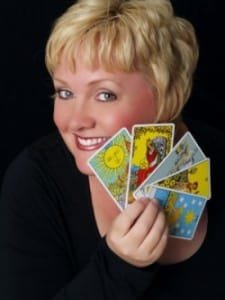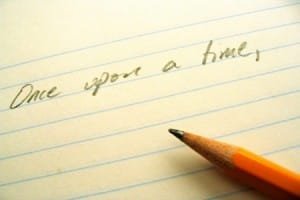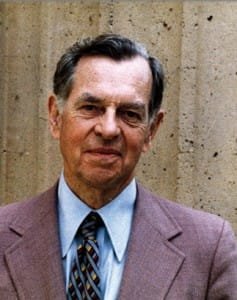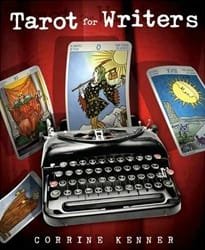Tarot for Writers by Corrine Kenner is an amazing resource for writers and storytellers across the world, who are looking for another source of inspiration for their work. Let’s have a look at what this book is all about.

Corrine Kenner
The way I see it, most Tarot card readers tell stories when they do their readings. They look at the spread positions, they look at the card images, they listen to their intuition, and they connect the dots to make a coherent story – the reading for their client. I firmly believe that in order to be a good Tarot card reader, one should have some ability for storytelling.
Naturally, the same Tarot cards can also inspire writers in their process of imagination weaving! The book Tarot for Writers by Corrine Kenner tells writers exactly how they can leverage the imagery and meanings of the Tarot cards to help them in their creative process.
The book Tarot for Writers by Corrine Kenner is divided into three main parts. Let’s take a quick look at each of these parts and what they are all about.
Tarot For Writers by Corrine Kenner
The book begins with a quick chapter that tells you how to use the book. It briefly touches upon the literary history of Tarot (the various ways and places that Tarot cards have appeared in literature). From there, Corrine moves on to the part where she tells us how Tarot cards can be a great brainstorming device. As she says, one can read the book in a straightforward, beginning to end manner, or, one can skip around if that suits.
After that, we move on to the first part of the book.
Part I: Tarot 101

This is the section where Corrine covers the basics of Tarot. While most Tarot readers are storytellers in some form, not all storytellers and writers are familiar with Tarot. So, we begin with the basic structure of a Tarot deck, and then go into the basics of the Majors and the Minors. This is followed up with information about the Court Cards.
The second chapter in this section talks about how one can read the Tarot cards. Corrine goes into the basics of reading like doing a quick meditation before the reading, and then she talks about a step-by-step way of laying down a spread and doing a reading. Of course, since the ideal reader for this book isn’t a Tarot card reader, this process can seem to quick. But it will make some sense in the end, promise.
The next chapter talks about some typical Tarot reading spreads used by Tarot card readers across the world. She begins with one card, two card and three card spreads, and then goes into the Horseshoe Spread and ends with the Celtic Cross. All of these spreads have sample readings that should help any writer get into the groove of the cards.
Within the second and third chapters of this section, you will find a ‘Writing Practice’ exercise, which will be very helpful. My suggestion is to work through these exercises as you move forward through the book. Not only will these exercises drive the point home, but they will also help you connect with the cards better, and give you a chance to actually figure out how the cards work for you. As the Apprentice in the 8 of Pentacles may say, many a times, the learning happens with doing!
These exercises continue through the next section of the book as well.
Part II: The Writer’s Tarot
This is the part that most writers will be familiar with. This section deals mainly with the various aspects of creative writing and how the Tarot cards can come in handy at each of these places.
 The first chapter focuses on character creation. As a writer I know, most stories have several focal points that drive it forward. Characters are one such focal point – after all, isn’t the story about the people who are in the story? Here, we learn how to use the Tarot cards in the process of creating and building the characters and their personalities. Tarot for Writers by Corrine Kenner also uses a great list of Tarot archetypes to help a writer find more details about the character he is building or creating.
The first chapter focuses on character creation. As a writer I know, most stories have several focal points that drive it forward. Characters are one such focal point – after all, isn’t the story about the people who are in the story? Here, we learn how to use the Tarot cards in the process of creating and building the characters and their personalities. Tarot for Writers by Corrine Kenner also uses a great list of Tarot archetypes to help a writer find more details about the character he is building or creating.
Astrology has always had some very deep connections with the Tarot cards. The next chapter in this section gets into that very same connection. Here we learn about the Major Arcana and their correlations with the different planets and sun signs. These too are very useful tools for writers to glean more about their characters. Here Corrine uses the Zodiac Spread to give a quick overview of the 12 Houses in astrological charts, and how these can be used in the character creation and building process for any writer.
Along with the character, the plot also drives any story. While each character has their own storyline and character arc, the plot is the one thread that pretty much holds it all together. Again, this will be familiar territory for writers as Corrine gets into the standard 3 Act Structure, and talks about how the Tarot cards can be used to chart the plot in that structure. A modified version of the Celtic Cross is also presented to us writers so that we can use it to devise the plot for the story. Topics of multiple storylines and sub-plots are also discussed.

Joseph Campbell
The next chapter looks at the Hero’s Journey. First experienced in Joseph Campbell’s ‘A Hero with a Thousand Faces’, this structure has also garnered a lot of appeal with writers. Using the Tarot cards, Corrine describes how writers can chart the course of the journey of their story’s hero / heroine using the Hero’s Journey as a guideline. And of course, there is a Hero’s Journey Spread to help out with the process.
As with the characters and the plots, the setting is another factor that matters for a story. The setting is where the story is actually taking place. And if used well, the setting too contributes to the story! Using the Tarot cards to determine the details of your setting is truly an experience to look forward to. Corrine also shows how one can use the images of the Tarot cards combined with the five senses to determine more details about the setting.
Writer’s Block is one of the major hurdles in the writing process. One way or the other, every writer has experienced some form of writer’s block during their writing careers. In Tarot for Writers by Corrine Kenner, you will find how to use the Tarot cards to find a way out of writer’s block. If you are a writer participating in a writer’s group, then Corrine also has an interesting game which you can use in the group to help with your writing.
And if you are looking to go deeper and make your connection with the cards stronger, then this next chapter will be just right for you. Here, Corrine advises you to go ahead and ask the cards all those weirdly strange questions that keep popping up while you write. Questions from ‘Which sections of your story should you delete’ to ‘How to your characters feel about you as their creator’ – all these and more can be addressed to the cards. 🙂
Part III: A Writer’s Guide to Tarot Cards
This third section of the book will prove to be very useful for most writers who intend to use Tarot for Writers by Corrine Kenner for exploring their writing using the Tarot cards. In this section, Corrine puts together all the information about each of the 78 cards of a Tarot deck in a neat easy-to-refer manner. I promise you, once you’ve gotten the hang of the techniques, you will be coming back to this section often to look at the various meanings and connections that the cards have to provide.
For the Major Arcana, Corrine talks about the meanings of the card, the various symbols on the card with their meanings, keywords to help you recall the card meanings, the astrological association, mythological connections, literary connections and finally, writing prompts for your writing exercises.
For the Minor Arcana, Corrine talks about the meaning of the card, the various symbols on the card with their meanings, keywords and then gives you writing prompts. For the Court Cards, the astrological and elemental connections are also included.
Conclusion
At the end of the book, you will find a glossary of the various terms and symbols used in Tarot. Again, this is a section to which most of you will be returning to for reference.
My Thoughts
As a Tarotist and as a Writer, I have found the techniques mentioned in this book quite useful. I have personally used many of these techniques in the process of writing out the outline of the novel that I am working on at this time. And I have found them to be very useful and insightful. Of course, I used several different decks to get into it, and trust me, the more imagery, the more intense and better the process turned out to be.
If you are a writer and are looking for inspiration for your next project, I can promise you one thing: you certainly get that! I can understand the trepidation for a writer who isn’t into Tarot, but believe me, that will not be a hurdle in this process. You don’t have to get into the depths of the Tarot that much – just have to use your imagination and look at the images and let loose with your creative juices!
Your Turn…
I have found Tarot for Writers by Corrine Kenner to be tremendously useful during my writing and planning for writing phases. What about you? What have your experiences been like? If you haven’t read the book before, do you plan on getting a copy for yourself? Why? 🙂
Please do share your thoughts in the comments section below.











I never lose the sense of awe I feel each and every time some synchronized event weaves its message into my day, breezing through with answers to questions I hadn’t even meditated, chanted, did a reading for, or anything. I came across this post by pure accident (originally looking for a spread I could do using two decks to represent two people, but not lovers.) My journal lies in front of me. A blank page begging for attention. I could write for hours but lately have had a stale feeling, tired of free writing, or writing about the situations that I find myself in, which make me feel like I am only rewriting what I’ve already written, as my life events arise in patterned themes. It was on my mind to write about the tarot, but I didn’t know what. My own book of spreads? Interpretations? Not original enough to not become a chore left unfinished. I NEED THIS BOOK!
🙂
Christie, I’ve totally been where you are now – staring at the blank page of the journal, feeling as if I’ve written all that I could or would ever write! But you know what, sometimes, you just need a little nudge to get back on the writing track. And yes, the Tarot cards can be a very useful nudge.
I would totally recommend this book to get yourself going in that direction. So yeah, go for it.
And please do share your thoughts and comments about the book when you finish reading through it…
How cool that you’re doing Nanowrimo this year, too! Synchronicity is working overtime these days.
I visited the site for the OH cards, and will probably end up buying one or two decks… The 1001 deck looks especially intriguing.
I hope we’ll continue our correspondence.
Thanks for the tip about the cards, and happy writing in November.
Hey!
You’re welcome!
Happy NaNo-ing to you too!
Let me know which decks you get.. Maybe I’ll do a post about these cards in the future, what say?
How cool that you’re doing Nanowrimo this year, too! Synchronicity is working overtime these days.
I visited the site for the OH cards, and will probably end up buying one or two decks
Hello, Madhavi! I’ve been meaning to write to you for some time now, to tell you how much I am enjoying your blog. This post on tarot for writers is such an amazing example of synchronicity for me, and I felt I must share it with you.
I have been interested in tarot for many years now, and have made several forays into learning the art with limited success. This summer, I had a reading done at the Georgia Renaissance Festival, and decided to dust off my cards and books again and see if I could finally develop a consistent practice. I thought that tarot might be a great vehicle for storytelling, and a Google search pointed me to one of your blog posts on storytelling with the cards. I have been dipping into your blog ever since, picking posts as they seem relevant to my learning at a given moment. I love how you have organized your posts, and how each article contributes to my growing understanding and competence.
Here’s the freaky part… I have decided to participate in National Novel Writing Month (nanowrimo.org), a challenge to write a 50,000 word novel in 30 days. I thought I’d use the cards as part of my brainstorming and warm-up for nanowrimo, which reminded me that I hadn’t visited your blog since early September. I couldn’t believe how synchronous this post is! This book is exactly the resource I need right now. I immediately downloaded the book to Kindle and started reading… In the preface, the author says the book began as an article she wrote in 2006 for National Novel Writing Month. A complete circle, complete validation. Utterly cool!
So, many many thanks, for the inspiration you’ve provided for integrating two creative endeavors into an exciting new process!
Hi Angana,
Wow! Its messages like yours that always make my day, and make this entire blog worthwhile!
I am glad that you have always found my blog posts useful and relevant – and yes, synchronous with the events and needs in your life at certain given points of time…
The cards are a very wonderful tool for brainstorming, and this book is also very, very helpful. In fact, it is also another coincidence (but here it is on my part) that I am also planning to do NaNoWriMo this year for real. Of course, I am already in the middle of writing my novel’s first draft, so I will be doing a bit more than my daily word count for the month of November, and putting it up on the site… 🙂
And yes, I did use the cards and the methods in this book for my brainstorming process – and I can very well say that it works! 😛
I find the cards and the stories they tell to be an excellent source for brainstorming, and for clearing out any cobwebs in the plot (which almost invariably pop up from time to time)… And I sincerely hope that you too will find the cards useful for your your story planning, writing, (and re-writing) processes.
In my excursions into the world of cards and images on cards, I have also discovered a few other decks of cards which are also used for storytelling. I have two of those decks. These are called the OH Cards, and the decks I have are Saga and Mythos. Do have a look at these decks too – they are not used for doing readings for future prediction etc, but they are also excellent storytelling, planning-for-story tools, among other things. 🙂
I think I have probably led you down a slippery slope here – because once you get hooked on to buying decks, there’s no stopping… But then, one can’t always help it, right?
Once again, I am very grateful to hear from you about your interesting journey of synchronicity… Thanks for sharing it with me…
Madhavi